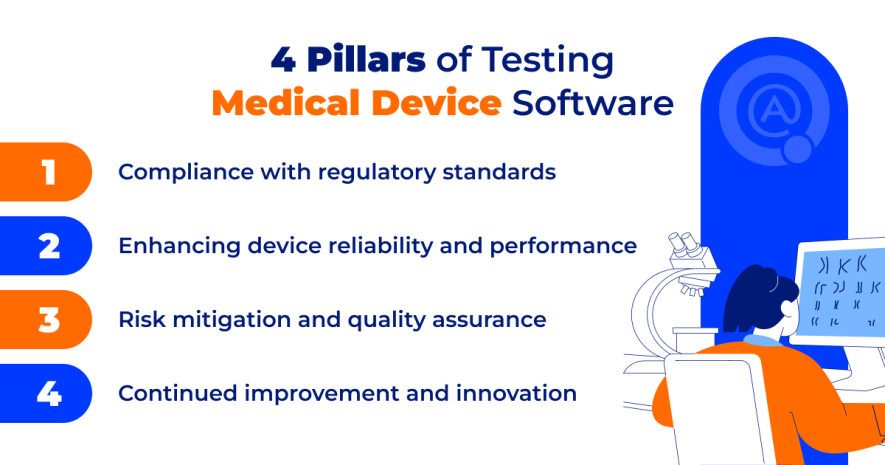- QATestLab Blog >
- QA Basics >
- Types of Software Testing >
- Functional Testing >
- The Importance of Medical Device Software Testing
The Importance of Medical Device Software Testing

Medical devices have revolutionized healthcare, enabling professionals in this field to diagnose, monitor, and treat patients with greater precision and efficiency. However, with the rapid advancements in technology, medical devices have become increasingly complex, often incorporating software that plays a critical role in their functionality.
Given the vital importance of this software, testing is essential to ensure patient safety, regulatory compliance, and the delivery of high-quality healthcare services.
In this article, we will explore the importance of medical device software testing and its impact on the healthcare industry.
What is Medical Device Software?
Medical device software refers to the computer programs, applications, and algorithms that are an integral part of medical devices. These software components enable medical devices to function, interact with users, process data, and perform specific medical tasks.
Medical device software can be found in a wide range of medical equipment, from simple handheld devices to complex imaging systems and implantable devices. Some common examples of medical device software include:
- Diagnostic software
- Therapeutic Software
- Monitoring Software
- Data management
- Mobile Medical Apps
Medical devices, such as infusion pumps, pacemakers, and imaging systems, rely heavily on software to function accurately and reliably. Flaws or errors in medical device software can have serious consequences, potentially putting patients’ lives at risk.
Software bugs, malfunctions, or vulnerabilities can lead to incorrect diagnoses, inaccurate treatment delivery, or even system failures during critical procedures.
Comprehensive healthcare software testing is vital to identify and rectify such issues before the devices are deployed for clinical use, ensuring patient safety and minimizing the risk of harm.
4 Pillars of Testing Medical Device Software
As a company with vast experience in testing healthcare and medical device software, we identify 4 pillars of testing products in this specific field.
Compliance with Regulatory Standards
Compliance with regulatory standards is of utmost importance when testing medical device software. Medical devices are subject to strict regulations and guidelines to ensure patient safety, device effectiveness, and data security. Testing must demonstrate that the software meets these requirements and adheres to industry standards.
At QATestLab, we make sure the medical device software meets all the required regulatory standards. Here is how we do that:
- Create a clear testing strategy that outlines how the testing processes will align with regulatory requirements.
- Identify potential risks associated with the software’s use and prioritize testing efforts accordingly.
- Document test procedures that detail how each aspect of the software will be tested.
- Create and maintain accurate and organized documentation of all testing activities, bug reports, test cases, and test results.
Enhancing Device Reliability and Performance
Medical devices often operate in critical and time-sensitive scenarios where reliability and performance are of utmost importance.
The software that controls these devices must be thoroughly tested to ensure seamless operation under varying conditions. Through comprehensive testing, manufacturers can identify and resolve performance bottlenecks, optimize resource utilization, and improve the overall reliability of the devices.
Robust software testing methodologies, including functional, performance, and interoperability with other software and medical device testing, help identify any weaknesses and ensure that medical devices consistently deliver accurate and timely results.

Risk Mitigation and Quality Assurance
Effective software testing for medical devices goes beyond identifying defects. It also plays a crucial role in risk mitigation and quality assurance. Testing helps identify potential risks associated with software usage, such as data breaches, unauthorized access, or cyber-attacks, allowing manufacturers to implement appropriate security measures.
Furthermore, software testing enables manufacturers to verify the device’s user interface, ensuring it is intuitive and user-friendly, which contributes to the overall quality of patient care. By conducting rigorous testing, developers can mitigate risks, ensure compliance with quality standards, and improve the overall user experience of medical devices.
Continued Improvement and Innovation
Software testing plays a vital role in the continuous improvement and innovation of medical devices. Regular testing allows manufacturers to gather valuable feedback, identify areas for improvement, and refine their products. It provides insights into user experiences, potential enhancements, and emerging requirements.
Incorporating feedback from independent QA vendors, manufacturers can drive innovation, develop more advanced features, and provide healthcare professionals with tools that enable better patient outcomes.

Types of Testing Required for Medical Device Software
Functional Testing
Functional testing focuses on verifying whether the software performs its intended functions accurately and according to specifications.
Unit Testing
Testing individual units or components of the software in isolation to ensure they work as expected.
Integration Testing
Testing interactions between different software modules or components to ensure they integrate seamlessly.
System Testing
Evaluating the complete medical device system to validate its functionality as a whole.
Regression Testing
Given the sensitive nature of medical devices and the potential risks associated with software errors, regression testing plays a vital role in maintaining the safety and effectiveness of medical device software.

Performance Testing
Performance testing is vital for medical device software to ensure that it operates efficiently under varying conditions and meets performance requirements.
Load Testing
Assessing the software’s performance under normal and peak load conditions to determine if it can handle the expected user workload.
Stress Testing
Evaluating the software’s behavior under extreme conditions to identify performance bottlenecks and potential failures.
Healthcare App Testing Checklist: Must-Test Functionality
Below is a checklist of must-test functionality for a healthcare app. This checklist can be adapted based on the specific features and functionalities of your healthcare app.
Conclusion
In an era where medical devices are becoming increasingly reliant on software, rigorous testing is imperative to ensure patient safety, regulatory compliance, and the delivery of high-quality healthcare.
By adhering to comprehensive testing methodologies, you can deliver safe and effective medical devices, instilling confidence in healthcare providers and ensuring better patient outcomes.
Contact us to learn more about our best practices in testing healthcare products and how they can be tailored to your specific software.

Learn more from QATestLab
Related Posts:
- VivaTech 2025: Wearable AI, Next-Gen Robotics, and Assistive Accessibility Devices
- Inside Shoptalk Europe 2025: Hunting Retail AI Insights
- When Summer Breaks Testing: How to Prevent QA Downtime During Vacations
About Article Author
view more articles







No Comments Yet!
You can be the one to start a conversation.